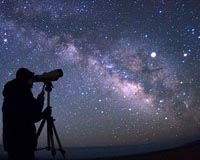 |
Paris, France (SPX) Sep 29, 2009 The third image of ESO's GigaGalaxy Zoom project has just been released online, completing this eye-opening dive into our galactic home in outstanding fashion. The latest image follows on from views, released over the last two weeks, of the sky as seen with the unaided eye and through an amateur telescope. This third instalment provides another breathtaking vista of an astronomical object, this time a 370-million-pixel view of the Lagoon Nebula of the quality and depth needed by professional astronomers in their quest to understand our Universe. The newly released image extends across a field of view of more than one and a half square degree - an area eight times larger than that of the full Moon - and was obtained with the Wide Field Imager attached to the MPG/ESO 2.2-metre telescope at the La Silla Observatory in Chile. This 67-million-pixel camera has already created several of ESO's iconic pictures. The intriguing object depicted here - the Lagoon Nebula - is located four to five thousand light-years away towards the constellation of Sagittarius (the Archer). The nebula is a giant interstellar cloud, 100 light-years across, where stars are forming. The scattered dark patches seen all over the nebula are huge clouds of gas and dust that are collapsing under their own weight and which will soon give birth to clusters of young, glowing stars. Some of the smallest clouds are known as "globules" and the most prominent ones have been catalogued by the astronomer Edward Emerson Barnard. The Lagoon Nebula hosts the young open stellar cluster known as NGC 6530. This is home for 50 to 100 stars and twinkles in the lower left portion of the nebula. Observations suggest that the cluster is slightly in front of the nebula itself, though still enshrouded by dust, as revealed by reddening of the starlight, an effect that occurs when small dust particles scatter light. The name of the Lagoon Nebula derives from the wide lagoon-shaped dark lane located in the middle of the nebula that divides it into two glowing sections. This gorgeous starscape is the last in the series of three huge images featured in the GigaGalaxy Zoom project, launched by ESO as part of the International Year of Astronomy 2009 (IYA2009). Through three giant images, the GigaGalaxy Zoom project reveals the full sky as it appears with the unaided eye from one of the darkest deserts on Earth, then zooms in on a rich region of the Milky Way using an amateur telescope, and finally uses the power of a professional telescope to reveal the details of a famous nebula. In this way, the project links the sky we can all see with the deep, "hidden" cosmos that astronomers study on a daily basis. The wonderful quality of the images is a testament to the splendour of the night sky at ESO's sites in Chile, which are the most productive astronomical observatories in the world. "The GigaGalaxy Zoom project's dedicated website has proved very successful, drawing hundreds of thousands of visitors from all around the world," says project coordinator Henri Boffin. "With the trilogy now complete, viewers will be able to explore a magnificently detailed cosmic environment on many different scales and take a breathtaking dive into our Milky Way." Share This Article With Planet Earth
Related Links GigaGalaxy Zoom Astronomy News from Skynightly.com
 The Beauty Of The Universe, From Above And From Below
The Beauty Of The Universe, From Above And From BelowStockholm, Sweden (SPX) Sep 28, 2009 The 2009 Lennart Nilsson Award is to be presented to American planetary scientist Carolyn Porco and Iranian photographer and science journalist Babak A. Tafreshi in recognition of their photographic work, which - each from its own perspective - recalls humankind's place in the universe. The prize is the world's most prestigious distinction in scientific and medical photography. ... read more |
|
| The content herein, unless otherwise known to be public domain, are Copyright 1995-2009 - SpaceDaily. AFP and UPI Wire Stories are copyright Agence France-Presse and United Press International. ESA Portal Reports are copyright European Space Agency. All NASA sourced material is public domain. Additional copyrights may apply in whole or part to other bona fide parties. Advertising does not imply endorsement,agreement or approval of any opinions, statements or information provided by SpaceDaily on any Web page published or hosted by SpaceDaily. Privacy Statement |